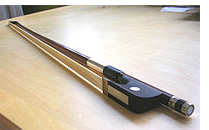|

 The art of bow making for the The art of bow making for the
violin family of instruments
has evolved since the 16th
century to meet the needs of
musicians and the demands
of
new musical styles. The
current
form of the bow —
the "modern bow"— was conceived during the last
quarterof the 18th century. At around this same time, pernambuco,
which had been imported to Europe from Brazil for 250 years for dye making, became the wood of choice for bow making. Pernambuco's unusual combination of density and flexibility allowed bowmakers to produce bows with extraordinary strength, resilience and balance.
Pernambuco remains as important to the world of string instrument
music today as it was when it was first identified as the best
bow making wood. Its combination of sonic qualities, density,
strength, suppleness, as well as its ability to bend with dry heat and
retain shape when cool (known as "memory") make it uniquely
suitable for making violin, viola, cello and bass bows. Although other potentially promising species have been identified none appear to
rival pernambuco. And while the quality of bows made from
synthetic materials such as carbon fiber have improved, there is a
broad consensus that these bows cannot achieve the sound and performance qualities that are possible with fine wood.
Physically, the bow is a relatively simple device. Bow making,
however, is a complex and challenging craft that requires dedication
and years of work to achieve a high level of proficiency. A good
bow maker must study the visual style and predominant trends throughout the different historical periods of bow making, and
must have mastered a wide variety of metal and woodworking skills
in order to make and assemble all of the parts of a bow with a high
degree of control. Most importantly, bow makers must understand
the particular properties of pernambuco.
As a species, pernambuco varies greatly in density, strength and
other characteristics. Changes in the grain and growth patterns of
an individual piece of wood can create stronger and weaker spots.
In general, the sound produced by good pernambuco will open up
as more of the wood is taken off. There is a threshold point, however,
after which the removal of more wood may cause bows to become
too soft to play or to begin to lose other important qualities. Finding
this "edge", as it is called, varies from one piece of wood to the
next and requires great individual attention. Subtle changes in
taper, camber, weight and balance can alter a bow's sound as
well as its flexibility, responsiveness and power. All of these aspects combine to make bow making a complex craft.
Most makers of fine bows create only one or very few bows at a
time. A highly skilled bow maker applies his or her training and
experience to recognize the specific characteristics and limitations of
each piece of wood and to shape it in a manner that maximizes and optimizes the sound it is capable of producing. The conservation
and replanting of pernambuco is essential to ensure the long-term
future of this extraordinary craft, which is inextricably linked with
violin making and string instrument playing.
|
|